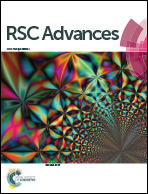Diamide-based fullerosteroidal and disteroidal [2]rotaxanes: solvent-induced macrocycle translocation and/or unthreading†
Abstract
The synthesis, characterization and behaviour of two novel Leigh-type amide [2]rotaxanes are reported. NMR study shows that fullerosteroidal and disteroidal rotaxanes occur in a peptide co-conformation in CDCl3. [D6]DMSO induces fast unthreading of disteroidal rotaxane, which includes steroid co-conformers as intermediates. On the other hand, fullerosteroidal rotaxane undergoes predominantly a shuttling process occupying the stacked co-conformation, whereas unthreading is very slow in comparison with its disteroidal analogue (25% after 7 days). Moreover, organogelation and self-organization properties were studied. It was found that disteroidal rotaxane is an organogelator and its SEM image shows that it forms a branched film-like network in a PhMe/EtOAc 1 : 1 mixture.
![Graphical abstract: Diamide-based fullerosteroidal and disteroidal [2]rotaxanes: solvent-induced macrocycle translocation and/or unthreading](/en/Image/Get?imageInfo.ImageType=GA&imageInfo.ImageIdentifier.ManuscriptID=C6RA03872G&imageInfo.ImageIdentifier.Year=2016)

 Please wait while we load your content...
Please wait while we load your content...